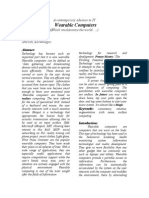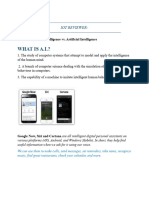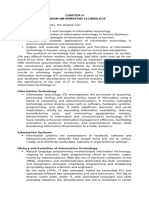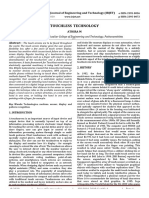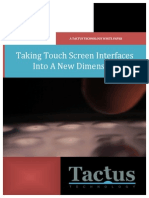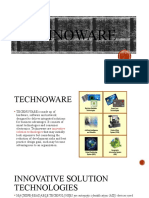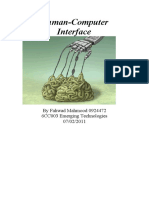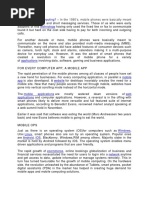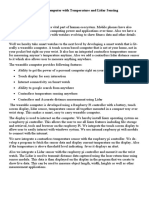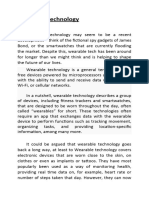Computers Would Be Useless Without Input Devices
Computers Would Be Useless Without Input Devices
Uploaded by
Danica ConcepcionCopyright:
Available Formats
Computers Would Be Useless Without Input Devices
Computers Would Be Useless Without Input Devices
Uploaded by
Danica ConcepcionCopyright
Available Formats
Share this document
Did you find this document useful?
Is this content inappropriate?
Copyright:
Available Formats
Computers Would Be Useless Without Input Devices
Computers Would Be Useless Without Input Devices
Uploaded by
Danica ConcepcionCopyright:
Available Formats
Computers would be useless without input devices.
Even small-scale
computers from calculators to GPS navigation systems require some input
from the human being in order to work properly and produce worthwhile
output. Some of the everyday input devices like keyboards, mice, joysticks
and microphones have reached increasingly more sophisticated levels of
technology. Other input devices that are available to the general public
but are generally used in commercial settings include touch-screens,
keypads for ATMs and bank card purchases, credit card scanners, bar code
readers, and more. However, new technology is constantly being developed to
create ever more sophisticated and futuristic input devices. Some of these,
like the digital signature capture pen and 3D body scanner, may never make
it into the common household but are nevertheless fascinating new
developments in technology. They enhance the ways in which human beings can
interact with machines. Some other new input devices discussed in the
Popular Science online magazine include touch screen GPS systems, fancy
digital music centers that operate independently from the PC, and the most
outlandish: the wearable computer. The wearable computer is mostly a thing
of fantasy but baby steps will continually be made to eventually enable the
entire human body to potentially interact with a computer.
The portable navigation systems currently out on the market are very
helpful for drivers, hikers, and campers. They usually require the user to
input coordinates in a cumbersome manner, by scrolling down a list and
manually inputting navigational points of reference. This tedious process
has been recently made more streamlined by the introduction of the touch
screen GPS system. However, this is really no different from the technology
used for touch screen computers; the difference is in the output of the
The advances in digital music...
Computers would be useless without input devices. Even small-scale
computers from calculators to GPS navigation systems require some input
from the human being in order to work properly and produce worthwhile
output. Some of the everyday input devices like keyboards, mice, joysticks
and microphones have reached increasingly more sophisticated levels of
technology. Other input devices that are available to the general public
but are generally used in commercial settings include touch-screens,
keypads for ATMs and bank card purchases, credit card scanners, bar code
readers, and more. However, new technology is constantly being developed to
create ever more sophisticated and futuristic input devices. Some of these,
like the digital signature capture pen and 3D body scanner, may never make
it into the common household but are nevertheless fascinating new
developments in technology. They enhance the ways in which human beings can
interact with machines. Some other new input devices discussed in the
Popular Science online magazine include touch screen GPS systems, fancy
digital music centers that operate independently from the PC, and the most
outlandish: the wearable computer. The wearable computer is mostly a thing
of fantasy but baby steps will continually be made to eventually enable the
entire human body to potentially interact with a computer.
The portable navigation systems currently out on the market are very
helpful for drivers, hikers, and campers. They usually require the user to
input coordinates in a cumbersome manner, by scrolling down a list and
manually inputting navigational points of reference. This tedious process
has been recently made more streamlined by the introduction of the touch
screen GPS system. However, this is really no different from the technology
used for touch screen computers; the difference is in the output of the
The advances in digital music...
Computers would be useless without input devices. Even small-scale
computers from calculators to GPS navigation systems require some input
from the human being in order to work properly and produce worthwhile
output. Some of the everyday input devices like keyboards, mice, joysticks
and microphones have reached increasingly more sophisticated levels of
technology. Other input devices that are available to the general public
but are generally used in commercial settings include touch-screens,
keypads for ATMs and bank card purchases, credit card scanners, bar code
readers, and more. However, new technology is constantly being developed to
create ever more sophisticated and futuristic input devices. Some of these,
like the digital signature capture pen and 3D body scanner, may never make
it into the common household but are nevertheless fascinating new
developments in technology. They enhance the ways in which human beings can
interact with machines. Some other new input devices discussed in the
Popular Science online magazine include touch screen GPS systems, fancy
digital music centers that operate independently from the PC, and the most
outlandish: the wearable computer. The wearable computer is mostly a thing
of fantasy but baby steps will continually be made to eventually enable the
entire human body to potentially interact with a computer.
The portable navigation systems currently out on the market are very
helpful for drivers, hikers, and campers. They usually require the user to
input coordinates in a cumbersome manner, by scrolling down a list and
manually inputting navigational points of reference. This tedious process
has been recently made more streamlined by the introduction of the touch
screen GPS system. However, this is really no different from the technology
used for touch screen computers; the difference is in the output of the
The advances in digital music...
You might also like
- Inputing Data in Other WaysDocument9 pagesInputing Data in Other WaysFai ShNo ratings yet
- Fundamentals of Wearable Computers and Augmented Reality, Second EditionDocument740 pagesFundamentals of Wearable Computers and Augmented Reality, Second EditionGcmarshall8267% (3)
- Gesture-Based Technology:: The Next Big Thing?Document1 pageGesture-Based Technology:: The Next Big Thing?AlbertoXavierNo ratings yet
- English 4 IT - Unit 17 Some Common Computer Input Devices ReadingDocument2 pagesEnglish 4 IT - Unit 17 Some Common Computer Input Devices ReadingdaudenmrNo ratings yet
- Smartphone TechnologiesDocument2 pagesSmartphone TechnologiesZakiryya RashidNo ratings yet
- Input and Output AssignmentDocument3 pagesInput and Output AssignmentSiti Nur Hafizah AdnanNo ratings yet
- Input Devices 1Document6 pagesInput Devices 1sedrick ocheNo ratings yet
- Wearable Computers Seminar ReportDocument7 pagesWearable Computers Seminar ReportAman SaxenaNo ratings yet
- National University of The EastDocument11 pagesNational University of The EastMarcelo VelazquezNo ratings yet
- Surface Computing Final ReportDocument34 pagesSurface Computing Final ReportSaurav SaurateNo ratings yet
- Inglês - Task I - PortfolioDocument8 pagesInglês - Task I - PortfolioAna Júlia da SilvaNo ratings yet
- Social Production Driven by IT: by Mitish Desai PGDM E-BusinessDocument6 pagesSocial Production Driven by IT: by Mitish Desai PGDM E-BusinessMitish DesaiNo ratings yet
- Input DevicesDocument28 pagesInput DevicesL NNo ratings yet
- Wearable ComputerDocument6 pagesWearable ComputerSwathi SadanandanNo ratings yet
- Iot ReviewerDocument9 pagesIot Reviewerdelapena.kategabrielle.cNo ratings yet
- Irjet V7i3870Document6 pagesIrjet V7i3870Sivasai KannikantiNo ratings yet
- Describe Any Two Input Devices and Two Output Devices in Detail and Explain The Developments That Occurred On These Devices Over The YearsDocument6 pagesDescribe Any Two Input Devices and Two Output Devices in Detail and Explain The Developments That Occurred On These Devices Over The YearsTafadzwa Dhliwayo100% (1)
- Input DevicesDocument3 pagesInput DevicesManuel AndradeNo ratings yet
- Contestants: P.Ajay Kishore K.Rajesh R.Surya KumarDocument6 pagesContestants: P.Ajay Kishore K.Rajesh R.Surya KumarfarhanajayNo ratings yet
- COF 111 Module-1Document49 pagesCOF 111 Module-1Eddie Angco TorremochaNo ratings yet
- Input DevicesDocument10 pagesInput DevicesKamran Abdullah100% (1)
- AI Virtual Mouse and KeyboardDocument12 pagesAI Virtual Mouse and Keyboard4219- RupaNo ratings yet
- Digital JeweleryDocument13 pagesDigital JeweleryTharun ReddyNo ratings yet
- PixelSensecollege ReportDocument30 pagesPixelSensecollege ReportPankaj KumarNo ratings yet
- Seminar3 SynopsisDocument13 pagesSeminar3 SynopsisSwapnil PatilNo ratings yet
- CHAPTER 3 Operations Management MADocument24 pagesCHAPTER 3 Operations Management MAJoseph TuldaNo ratings yet
- Abttt ReportDocument8 pagesAbttt ReportAko tohNo ratings yet
- Unit 1 Digital DevicesDocument91 pagesUnit 1 Digital Devicesmuhammad naufalNo ratings yet
- User InterfacesDocument1 pageUser InterfacesВо ВаNo ratings yet
- Input Output DIVISHADocument25 pagesInput Output DIVISHANifty GuptaNo ratings yet
- Irjet V7i3870Document10 pagesIrjet V7i3870Abhishek SukhasareNo ratings yet
- Antony Abhishek Infant John Manikanta Gowtham A Pavan Kumar KDocument6 pagesAntony Abhishek Infant John Manikanta Gowtham A Pavan Kumar KPavan KumarNo ratings yet
- InfoDocument10 pagesInfoILFA SALEEMNo ratings yet
- Form 2 It NotesDocument5 pagesForm 2 It NotesAdmire MarimaNo ratings yet
- ICT Class 9 & 10 PDFDocument6 pagesICT Class 9 & 10 PDFmukeshNo ratings yet
- Input Devices and MediaDocument9 pagesInput Devices and MediaSasha BurkeNo ratings yet
- Touch Screen Technology 1BI17MCA07: Dept. of MCA, BIT 2019 Page - 1Document17 pagesTouch Screen Technology 1BI17MCA07: Dept. of MCA, BIT 2019 Page - 1Auchitya SinghNo ratings yet
- Leap Motion SeminarDocument10 pagesLeap Motion SeminarJay PoojaraNo ratings yet
- Input DevicesDocument34 pagesInput DevicesBibin JoseNo ratings yet
- Digital JewelleryDocument6 pagesDigital JewelleryAviral12345No ratings yet
- Presentation 1Document10 pagesPresentation 1themohdhasnainNo ratings yet
- BAIN BRIEF Leading A Digical TransformationDocument16 pagesBAIN BRIEF Leading A Digical TransformationAnh VuNo ratings yet
- CH 5Document44 pagesCH 5Usama KhalidNo ratings yet
- E BookDocument9 pagesE BookVikasNo ratings yet
- PedroDocument2 pagesPedrososoheart90No ratings yet
- 2####Document9 pages2####RAFI ULLAH RAFINo ratings yet
- Lecture Slides of Week 6(0)Document8 pagesLecture Slides of Week 6(0)Ayeaha SaddiqaNo ratings yet
- Tactus Technology White PaperDocument13 pagesTactus Technology White PaperAbizer VejlaniNo ratings yet
- AI Emerging TrendsDocument8 pagesAI Emerging TrendsSonia SharmaNo ratings yet
- Input and Output DevicesDocument77 pagesInput and Output DevicesjoanNo ratings yet
- TECHNOWAREDocument17 pagesTECHNOWARERowena MangiNo ratings yet
- Digital ArtDocument25 pagesDigital Artcvriouss cqtNo ratings yet
- Mis DoxDocument4 pagesMis DoxammmmmuuuNo ratings yet
- Computer Embracement in NigeriaDocument10 pagesComputer Embracement in NigeriaosakingsNo ratings yet
- Information TechnologyDocument8 pagesInformation TechnologyanjaliNo ratings yet
- Seminar ON Surface ComputingDocument20 pagesSeminar ON Surface Computingankitsadana1990No ratings yet
- Computer Application in BusinessDocument13 pagesComputer Application in BusinessSharif MahmudNo ratings yet
- Class Ix Unit 2Document102 pagesClass Ix Unit 2ashwinbhatlawande12No ratings yet
- Human Computer InterfaceDocument5 pagesHuman Computer Interfacerafay2009No ratings yet
- What Is Mobile ComputingDocument6 pagesWhat Is Mobile ComputingReunion MabasaNo ratings yet
- RFBT Reviewer:: TrueDocument3 pagesRFBT Reviewer:: TrueDanica ConcepcionNo ratings yet
- There Are 2 Types of MonitorsDocument2 pagesThere Are 2 Types of MonitorsDanica ConcepcionNo ratings yet
- Fokine Went To The USADocument3 pagesFokine Went To The USADanica ConcepcionNo ratings yet
- Question 1Document3 pagesQuestion 1Danica ConcepcionNo ratings yet
- Origin and History of BalletDocument2 pagesOrigin and History of BalletDanica ConcepcionNo ratings yet
- MSQ 02 Variable Absorption CostingDocument11 pagesMSQ 02 Variable Absorption CostingDanica ConcepcionNo ratings yet
- Social Dance Can Derive From or Be An Activity Within Many Different GenresDocument2 pagesSocial Dance Can Derive From or Be An Activity Within Many Different GenresDanica ConcepcionNo ratings yet
- A Swollen Earlobe Can Be RedDocument2 pagesA Swollen Earlobe Can Be RedDanica ConcepcionNo ratings yet
- In Renaissance Time in Italy Ballet Was The Type of Entertainment On Aristocratic WeddingsDocument3 pagesIn Renaissance Time in Italy Ballet Was The Type of Entertainment On Aristocratic WeddingsDanica ConcepcionNo ratings yet
- Net Revenues For The Third Quarter of Fiscal 2008 Increased by 11Document2 pagesNet Revenues For The Third Quarter of Fiscal 2008 Increased by 11Danica ConcepcionNo ratings yet
- NOTES Variable CostingDocument1 pageNOTES Variable CostingDanica ConcepcionNo ratings yet
- ReactDocument1 pageReactDanica ConcepcionNo ratings yet
- PICDocument16 pagesPICDanica ConcepcionNo ratings yet
- Reaction Paper Comfort WomenDocument1 pageReaction Paper Comfort WomenDanica ConcepcionNo ratings yet
- Media and Information Literacy Quarter 2 - Module 1: Current and Future Trends of Media and Information Modules 1-2Document24 pagesMedia and Information Literacy Quarter 2 - Module 1: Current and Future Trends of Media and Information Modules 1-2Rodge Cancino100% (2)
- Digital JewelleryDocument9 pagesDigital JewelleryTouseef ahmedNo ratings yet
- HONOR Band 5 Sport User Guide - (AW70,01, En-Us)Document32 pagesHONOR Band 5 Sport User Guide - (AW70,01, En-Us)Jones MarxNo ratings yet
- Types of Personal ComputerDocument12 pagesTypes of Personal ComputerGab PeraltaNo ratings yet
- Computers in Human Behavior: Jo Ao J. Ferreira, Cristina I. Fernandes, Hussain G. Rammal, Pedro M. VeigaDocument10 pagesComputers in Human Behavior: Jo Ao J. Ferreira, Cristina I. Fernandes, Hussain G. Rammal, Pedro M. VeigaMY LÊ THỊ TRÀNo ratings yet
- Google GlassDocument17 pagesGoogle GlassNagarajuNeeliNo ratings yet
- Module 1 Current and Future Trends of Media and InformationDocument22 pagesModule 1 Current and Future Trends of Media and InformationShane BellenNo ratings yet
- Google Glass PresentationDocument25 pagesGoogle Glass PresentationVenu Kinng100% (1)
- Google Glass Seminar ReportDocument30 pagesGoogle Glass Seminar ReportVishalSahNo ratings yet
- ppt-CHILD SAFETY WEARABLE DEVICEDocument13 pagesppt-CHILD SAFETY WEARABLE DEVICEAkshay byp100% (1)
- Apple Super Healthy KidsDocument352 pagesApple Super Healthy KidsGizmodo EditNo ratings yet
- Digital Jewellery Paper PresentationDocument9 pagesDigital Jewellery Paper Presentationkavya_lahari0% (2)
- A Project ReportDocument62 pagesA Project Reportrajputratan294No ratings yet
- Wearable ComputerDocument9 pagesWearable Computerhowida nafaaNo ratings yet
- TLE9 Q1 Mod1 Introduction To Computer v2Document44 pagesTLE9 Q1 Mod1 Introduction To Computer v2Geraldin Monesit GonzalesNo ratings yet
- Google Glass Seminar ReportDocument30 pagesGoogle Glass Seminar Reportvivek2mb100% (3)
- Algorithms and The Social Organization of Work - Paper LSE - Ifeoma Ajunwa and Rachel Schlund - Oxford Handbook of Ethics of AIDocument22 pagesAlgorithms and The Social Organization of Work - Paper LSE - Ifeoma Ajunwa and Rachel Schlund - Oxford Handbook of Ethics of AICleber Daniel PaivaNo ratings yet
- PDF Fundamentals of Wearable Computers and Augmented Reality Second Edition Barfield downloadDocument71 pagesPDF Fundamentals of Wearable Computers and Augmented Reality Second Edition Barfield downloadhussebsacato100% (5)
- Wearables and The Internet of Things IoT ApplicatiDocument12 pagesWearables and The Internet of Things IoT ApplicatiamitxgaNo ratings yet
- Wearable Computer With Temperature and Lidar SensingDocument3 pagesWearable Computer With Temperature and Lidar Sensingtejas patilNo ratings yet
- Schwabs WEF Is Now Pushing To Implant Tracking Microchips in Humans As Part of The Great Reset AgendaDocument10 pagesSchwabs WEF Is Now Pushing To Implant Tracking Microchips in Humans As Part of The Great Reset AgendaJunet SitumorangNo ratings yet
- Wearable ComputerDocument9 pagesWearable ComputerAidan RamosNo ratings yet
- Wearable Smart Technologies: New Era of TechnologyDocument65 pagesWearable Smart Technologies: New Era of TechnologyAlam CarrascoNo ratings yet
- Wearable Android Android Wear and Google FIT App Development 1st Edition Sanjay M. Mishra All Chapters Instant DownloadDocument55 pagesWearable Android Android Wear and Google FIT App Development 1st Edition Sanjay M. Mishra All Chapters Instant Downloaderisscoulal100% (1)
- Sixth Sense Technology: By:-Animesh Kumar Tilak (1605340)Document11 pagesSixth Sense Technology: By:-Animesh Kumar Tilak (1605340)Animesh Kumar TilakNo ratings yet
- WEEK 1 TLE9 - Q1 - Mod1 - Introduction To Computer v2Document36 pagesWEEK 1 TLE9 - Q1 - Mod1 - Introduction To Computer v2July Rose ClaveriaNo ratings yet
- Virtual Keyboard Seminar ReportDocument24 pagesVirtual Keyboard Seminar Reportlittlerasikan100% (1)
- Literature Survey Report On 6th Sense TechDocument5 pagesLiterature Survey Report On 6th Sense TechNicole PierceNo ratings yet







